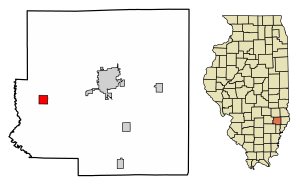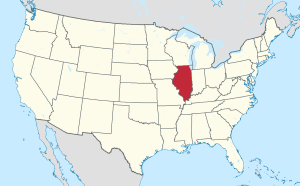Noble, Illinois facts for kids
Quick facts for kids
Noble
|
|
|---|---|

Location of Noble in Richland County, Illinois.
|
|

Location of Illinois in the United States
|
|
| Country | United States |
| State | Illinois |
| County | Richland |
| Area | |
| • Total | 1.02 sq mi (2.65 km2) |
| • Land | 1.02 sq mi (2.63 km2) |
| • Water | 0.01 sq mi (0.01 km2) |
| Elevation | 476 ft (145 m) |
| Population
(2020)
|
|
| • Total | 633 |
| • Density | 622.42/sq mi (240.32/km2) |
| Time zone | UTC-6 (CST) |
| • Summer (DST) | UTC-5 (CDT) |
| ZIP Code(s) |
62868
|
| Area code(s) | 618 |
| FIPS code | 17–53143 |
| GNIS feature ID | 2399500 |
| Wikimedia Commons | Noble, Illinois |
| Website | http://www.nobleillinois.com/ |
Noble is a village in Richland County, Illinois, United States. In 2020, the population was 633 people. It is a small community located in the central part of Illinois.
Contents
Exploring Noble's Location
Noble is a village in Richland County, Illinois, United States. It covers a total area of about 1.025 square miles (2.65 square kilometers). Most of this area is land, with a very small part being water.
Understanding Noble's Population
The population of Noble has changed over many years. Records show how many people have lived in the village during different time periods.
| Historical population | |||
|---|---|---|---|
| Census | Pop. | %± | |
| 1860 | 127 | — | |
| 1870 | 380 | 199.2% | |
| 1880 | 502 | 32.1% | |
| 1900 | 424 | — | |
| 1910 | 618 | 45.8% | |
| 1920 | 580 | −6.1% | |
| 1930 | 473 | −18.4% | |
| 1940 | 855 | 80.8% | |
| 1950 | 776 | −9.2% | |
| 1960 | 761 | −1.9% | |
| 1970 | 719 | −5.5% | |
| 1980 | 832 | 15.7% | |
| 1990 | 756 | −9.1% | |
| 2000 | 746 | −1.3% | |
| 2010 | 677 | −9.2% | |
| 2020 | 633 | −6.5% | |
| U.S. Decennial Census | |||
Population Details from 2000
In the year 2000, there were 746 people living in Noble. These people lived in 318 households, and 213 of these were families. The village had about 729 people per square mile.
Many households, about 30.8%, had children under 18 living with them. More than half, 51.6%, were married couples living together. About 16% of households had someone living alone who was 65 years old or older.
The average age of people in Noble in 2000 was 36 years old. About 25.9% of the population was under 18. Another 16.4% of the population was 65 years or older.
See also

- In Spanish: Noble (Illinois) para niños

